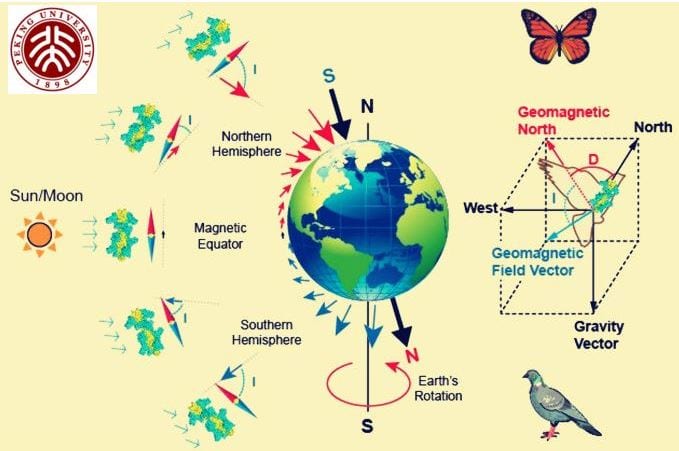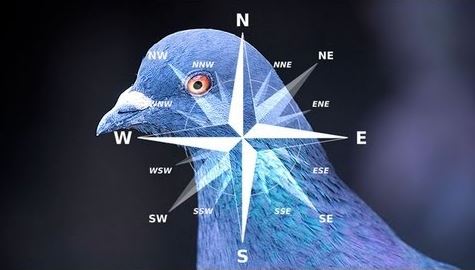A rod-shaped complex of proteins gives animals their biological compass needle that helps them tell north from south in Earth’s magnetic field, says a team of Chinese scientists who carried out a study on fruit flies. It is thanks to these proteins that, for example, birds know where to go when they migrate.
Scientists have long wondered how animals can detect the Earth’s magnetic field and instinctively know where north is. Nobody could explain how this innate magnetic sense exists in several animals, including whales, wolves, worms, butterflies, birds and humans – that is, until now. Even dogs position themselves in a north-south axis when pooping.
Study leader, biophysicist Xie Can, from Peking University in Beijing, and colleagues, who published their findings in the academic journal Nature Materials, said the biocompass could become an invaluable tool for using magnetic fields to control cell processes.
 Many animals, including humans, have a biological compass that helps them navigate. (Image: Peking University)
Many animals, including humans, have a biological compass that helps them navigate. (Image: Peking University)
The Guardian quoted Xie as saying:
“The nanoscale biocompass has the tendency to align itself along geomagnetic field lines and to obtain navigation cues from a geomagnetic field.”
“We propose that any disturbance in this alignment may be captured by connected cellular machinery, which would channel information to the downstream neural system, forming the animal’s magnetic sense.”
David Cyranoski, writing in Nature News, quotes Peter Hore, a biochemist at the University of Oxford, UK, who said:
“It’s an extraordinary paper. But Xie’s team has not shown that the complex actually behaves as a biocompass inside living cells, nor explained exactly how it senses magnetism.”
Nature News also quoted David Keays, a neuroscientist who specializes in magnetoreception at the Institute of Molecular Pathology in Vienna, who said “It’s either a very important paper or totally wrong. I strongly suspect the latter.”
Cryptochromes
In their quest to find animals’ biological compass, scientists have pointed to cryptochromes (a class of flavoproteins that are sensitive to blue light). When fruit flies lack the proteins their sensitivity to magnetic fields is lost.
 Without its biological compass, the homing pigeon would not be able to find its way back home.
Without its biological compass, the homing pigeon would not be able to find its way back home.
However, cryptochromes cannot act as a compass on their own, Xie explains, because they are unable to sense the north-south orientation (polarity) of magnetic fields.
Some researchers have suggested that iron-based minerals, such as magnetite, which has been found in homing pigeons’ beaks, may be responsible. However, several studies failed to find any magnetoreceptive qualities in the magnetite in pigeons’ beaks.
In this latest study, the team says it has found a protein in the fruit fly which both interacts with cryptochromes and binds to iron. Called CG8198, it binds to iron and sulfur atoms and plays a role in the fruit-fly’s biological clock (circadian rhythms).
A ‘nanoscale needle’
CG8198 and cryptochromes together provide a ‘nanoscale needle’: a rod-like core of CG8198 polymers coated on the outside with cryptochrome proteins that twist around the core.
With the use of an electron microscope, the researchers saw assemblies of these rods pointing themselves in a weak magnetic field just like a compass needle does.
Xie has now given CG8198 a new name – MagR (magnetic receptor).
The authors are excited about the prospect of using magnetic fields to control cell processes. Since the turn of the century, scientists have been commandeering the photo-sensing capacity of some proteins to manipulate neurons (nerve cells) by inserting a fiber-optic cable straight into the brain (optogenetics).
These proteins can be manipulated from outside the brain
Magnetosensing proteins can do something other methods can’t – they can be manipulated by magnetic fields outside the brain.
Xie says he submitted a Chinese patent application in April that includes using magnetogenetics and the protein’s magnetic capacity to manipulate large proteins.
The team has also begun looking at the structure of MagR proteins in humans. Xie believes people’s different sense of direction may be linked to variants of MagR.
In the same interview with The Guardian, Xie said:
“Human sense of direction is complicated. However, I believe that magnetic sense plays a key role in explaining why some people have a good sense of direction.”
Citation: “A magnetic protein biocompass,” Siying Qin, Hang Yin, Celi Yang, Yunfeng Dou, Zhongmin Liu, Peng Zhang, He Yu, Yulong Huang, Jing Feng, Junfeng Hao, Jia Hao, Lizong Deng, Xiyun Yan, Xiaoli Dong, Zhongxian Zhao, Taijiao Jiang, Hong-Wei Wang, Shu-Jin Luo & Can Xie. Nature Materials. 16 November, 2015. DOI: 10.1038/nmat4484.
